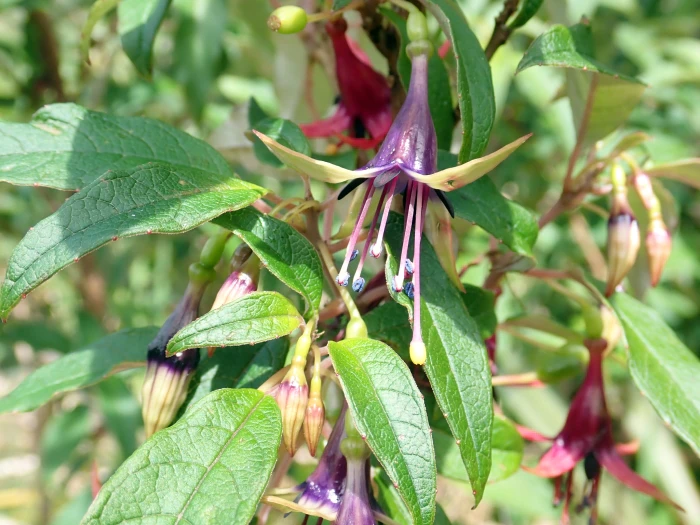New Zealand Fuchsia
(Fuchsia excorticata)
New Zealand Fuchsia (Fuchsia excorticata)
/
/

Peter de Lange
Public Domain
Image By:
Peter de Lange
Recorded By:
Copyright:
Public Domain
Copyright Notice:
Photo by: Peter de Lange | License Type: Public Domain | License URL: http://creativecommons.org/publicdomain/zero/1.0/ | Rights Holder: Peter de Lange | Publisher: iNaturalist | Date Created: 2020-10-21T11:01:49-07:00 |




















































Estimated Native Range
Climate Requirements for Palm Harbor, Florida
| This Plant | Your Site | Plant Suitability for Your Location | ||
|---|---|---|---|---|
| • Precipitation | 23" - 226" | 52" | Aquatic | Aquatic |
| • High Temp. | 52°F - 78°F | 91°F | Your summers may be too hot for this plant. | Too hot |
| • Low Temp. | 21°F - 50°F | 50°F | OK, but your winter temperatures are warmer than normal for this plant | OK |
This plant should grow well at your location with about N inches per year (Y minutes per month) of irrigation.
Summary
Fuchsia excorticata, commonly known as New Zealand Fuchsia, is a deciduous shrub or small tree native to the temperate rainforests and coastal forests of New Zealand. It is the largest species of Fuchsia in the world, reaching up to 12 meters in height with a trunk diameter of about 60 cm. The plant is characterized by its striking papery, light brown/orange bark that peels in strips, and stout, outreaching branches. Leaves are typically dark green on the upper side and paler, sometimes silver, on the underside, occasionally suffused with red or purple. The flowers, which are bright red to purple, are solitary and pendulous, emerging directly from the main stem. The four showy sepals are 5-16 mm long, and the filaments are purplish, ranging from 7-12 mm in length. After flowering, it produces ellipsoid-oblong berries that are dark purple to almost black, measuring approximately 10 mm long.
New Zealand Fuchsia is valued for its unique bark and vibrant flowers. It is often used in gardens for its ornamental qualities and as a conversation piece due to its unusual appearance. It is suitable for urban planting, border planting, and as a specimen tree in larger gardens. This species prefers moist, well-drained soil and can tolerate a range of light conditions from full sun to partial shade, although it naturally grows under a canopy in its native habitat. While it generally requires medium amounts of water, it is important to avoid waterlogged conditions. There are no major disease issues, but it can be sensitive to frost and requires protection in colder climates.CC BY-SA 4.0
New Zealand Fuchsia is valued for its unique bark and vibrant flowers. It is often used in gardens for its ornamental qualities and as a conversation piece due to its unusual appearance. It is suitable for urban planting, border planting, and as a specimen tree in larger gardens. This species prefers moist, well-drained soil and can tolerate a range of light conditions from full sun to partial shade, although it naturally grows under a canopy in its native habitat. While it generally requires medium amounts of water, it is important to avoid waterlogged conditions. There are no major disease issues, but it can be sensitive to frost and requires protection in colder climates.CC BY-SA 4.0
Plant Description
- Plant Type: Shrub
- Height: 15-40 feet
- Width: 25-35 feet
- Growth Rate: Moderate
- Flower Color: Purple, Red
- Flowering Season: Spring
- Leaf Retention: Deciduous
Growth Requirements
- Sun: Full Sun, Part Shade
- Water: Medium
- Drainage: Fast, Medium, Slow
Common Uses
Bee Garden, Bird Garden, Edible*Disclaimer: Easyscape's listed plant edibility is for informational use. Always verify the safety and proper identification of any plant before consumption., Hummingbird Garden, Potted Plant, Showy Flowers
Natural Habitat
Temperate rainforests and coastal forests of New Zealand
Other Names
Common Names: Tree Fuchsia, Konini, Kōtukutuku
Scientific Names: Fuchsia excorticata, Skinnera excorticata
GBIF Accepted Name: Fuchsia excorticata (J.R.Forst. & G.Forst.) L.fil.